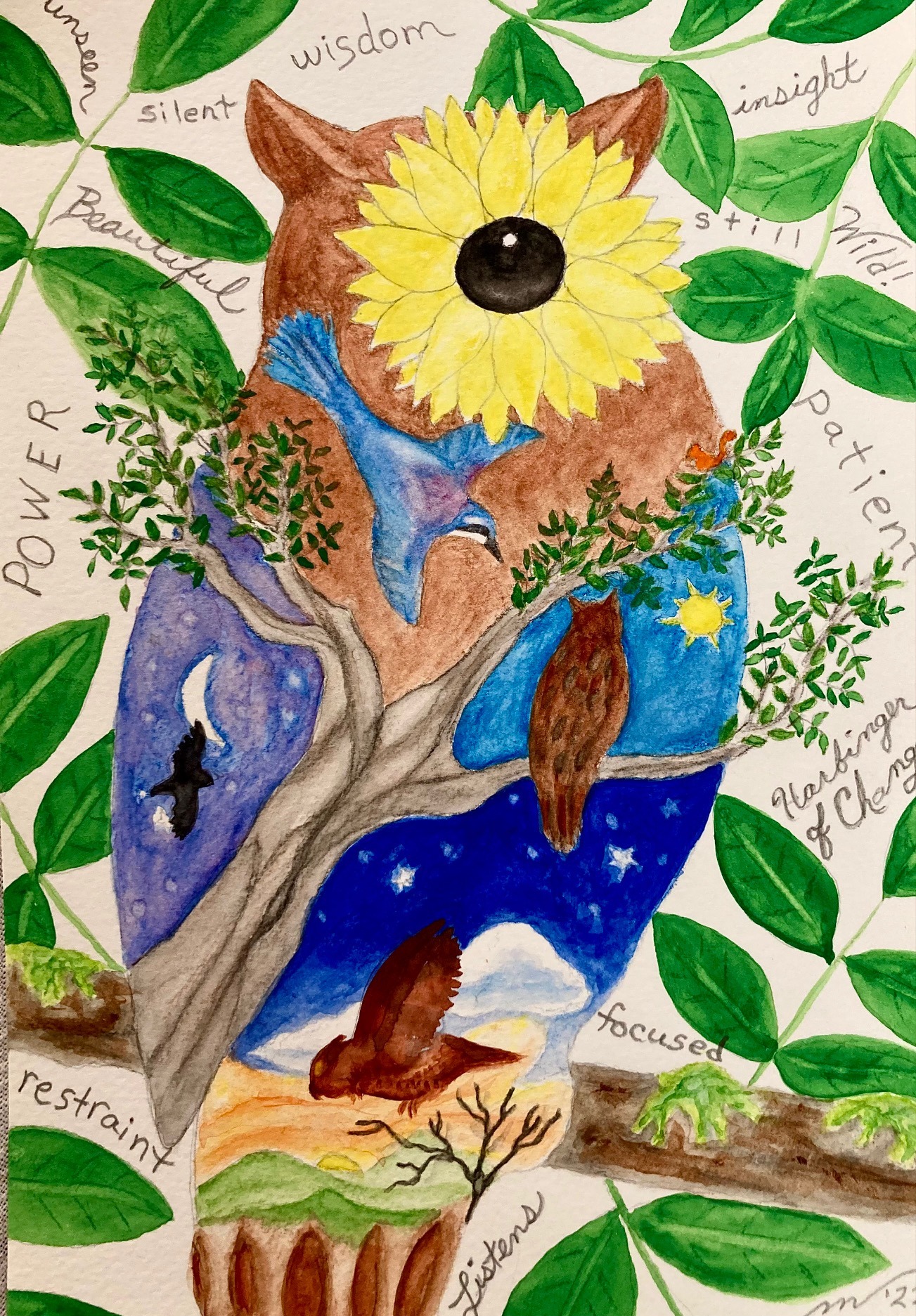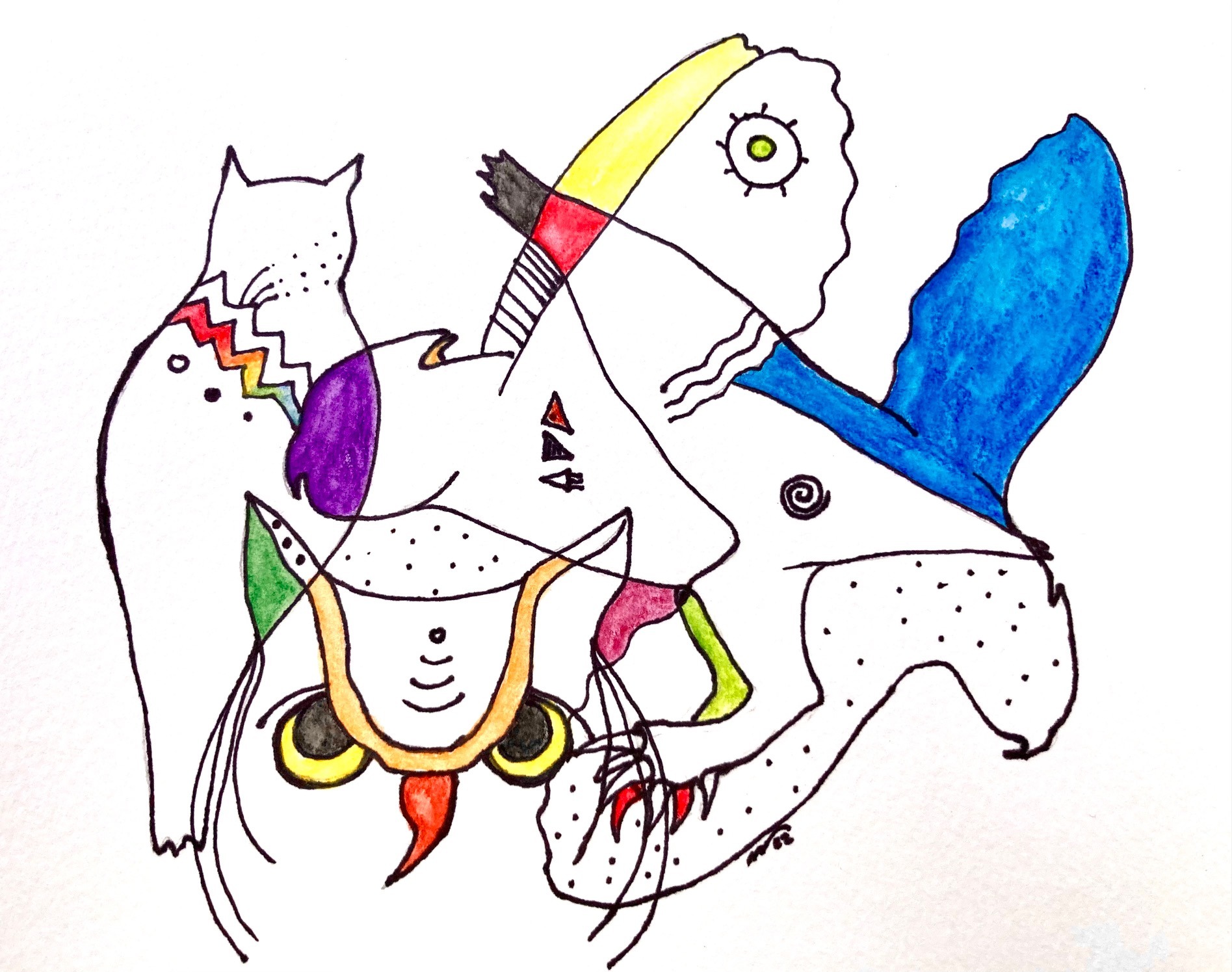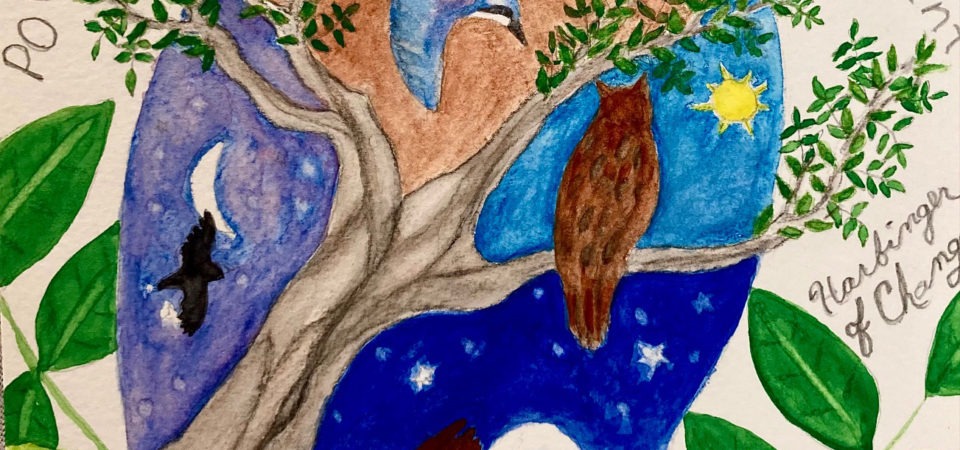Encountering the Wild Where We Are
This evening I was relieved to see her take flight. It was after dusk, and she had been very still in her sound sleep all day. Her eyelids were shut tight over her huge yellow eyes as the wind tousled her long, brown shawl of striped feathers. The tree branch upon which she was perched swayed and rocked as her strong talons gripped it like a confident surfer or a steady boat upon a restless sea. The weather was cool and cloudy, a welcome break from the heat wave that had been clutching the Northwest with ninety-degree plus temperatures. I couldn’t help but feel how soothing it must feel, secure on her landing and in a deep sleep like a baby being rocked to dreamland.
Nothing disturbed her rest today and I found myself lulled into a calm state observing this magnificent bird’s literal go-with-the-flow ability. What seemed very clear to me was that her sleep behavior changed for the better with the cooler weather. We humans are not the only ones affected by record-breaking heat, so it seems. For the past few weeks, the Great Horned Owl, who I recently began to observe, had been mostly a light sleeper. I witnessed her panting in the scorching afternoons up in the Douglas Fir by our house. Of course, she adapts, but what I observed was definite distress from the heat.
Had she always been there, in the ravine behind our house? We have heard owls at dawn and dusk off and on for the past two years since moving to our new home; and an owl flew deftly over our heads one night as we were stargazing. It was not until very recently, however, that I came to know this night-bird.
Sunflower for a return visit on an October morning.
I was at my large bedroom window where I sit while I meditate in the mornings. Suddenly the Steller’s Jays, Scrub Jays, and Flickers began to screech in alarm when the flash of a large brown wing fluttered on a branch heavy with leaves. For a moment, I had looked away and I couldn’t ascertain exactly what it was, but I knew it was a large bird of prey. During the spring, a Cooper’s Hawk made regular rounds to our small, wooded ravine to raid nests. However, I knew this was no hawk. The wing I saw was bigger than that of a hawk and immediately I realized an owl had just landed.
Abandoning my morning ritual, I ran to find binoculars. Sure enough, there on an alder tree directly across from my window, sat a Great Horned Owl. The giant bird barely flinched as the frantic birds dashed about her in their attempt to drive her away. She held her ground and then decided to move up to an arm of the tree where there was a cozy perching spot near the trunk…a perfect place to nap. The birds continued their harassment for a while until they tired and saw that the owl was unfazed by their threats.
There was a persistent Scrub Jay who was reluctant to give up on his unwelcoming gestures towards his big cousin. But he too, in time, pulled back. During the day I observed her preening herself (like a cat licking her hair – so cat-like in many ways with those ears and personal cleanliness), stretching her legs one at a time like a lithe dancer, looking around the area with curiosity, and dozing. I watched as a squirrel approached her on a nearby branch and witnessed the owl eyeing the rodent but then looking away. Surely, I pondered, I was going to be horrified when the owl attacked the squirrel… However, I witnessed disinterest and restraint when the owl clearly was seeing birds and squirrels nearby and didn’t even attempt to go after them. She was full and sleepy, without a doubt, and no threat to the ravine community during the day.
Due to her amazing camouflage, when I would return to observe the owl, it would take some time to locate her again. Even looking at the very branch where she was resting, at first, if I hadn’t known there was an owl there, she would blend in perfectly with the tree. Amazing! There happened to be a tall sunflower by the back fence that, when I looked directly above it, I could easily find the owl. It only seemed natural to refer to her as Sunflower, and so that became her name. Also, I knew she was a female because of her large size.
left: Blind contour drawing without looking.
right: Sketching from memory and writing in my journal: Sunflower eyes.
Later that day, I stepped out boldly to the fence to get a closer view. I didn’t want to disturb her, so I did my best to be quiet and stealthy. Yet, once I got to the fence, there she was, this incredibly gorgeous being, looking right at me. Our eyes locked for a time, and I felt as if she was peering deeply into my soul. I was in awe with tears in my eyes. I began to speak to her gently and she leaned her head down as if intently listening. It was then I noticed her eyes were the same color as the sunflower petals next to me. They looked like two sunflowers gazing into my being. Most unexpectedly, Sunflower became my familiar of a sort— an animal who I felt I had a deep connection to in a mysterious way. After a few minutes, the owl turned her head when a sound rattled through the tiny forest. My heart was pounding in my chest with excitement and gratitude. Sunflower touched the wild parts of my being that needed reawakening.
Over the days and weeks ahead, I would look for Sunflower. She would come and go, sometimes unseen for days at a time. Sometimes it was the jays who alerted me, so I’d run and get the binoculars, and sure enough, there was Sunflower. One evening I was at the fence looking for her, quite certain I could sense her presence, but I couldn’t see her. Then, I heard a loud “who-who.” There she was on the inverted V of the alder tree looking right at me! I hooted back and we gazed at each other for a few moments before she looked up at something rustling in the branches above her. She waited while I ran in to grab the camera and snapped a few photos of her before she spread her silent wings and vanished into the forest.
One morning, Sunflower was in a different alder tree to the right of the one where I first saw her. She was settling in for sleep while the pesky jay screeched at her from branch to branch. He was at the same level as the owl pecking at the tree. Using the binoculars, I focused on what he was doing, and this is what I saw. The Scrub Jay was collecting little pieces of bark, lichen, and tiny twigs in his beak. Then, he hopped up to a higher branch and started to release the stuff in his mouth little by little with short thrusts of his beak. In other words, the jay was dropping the sticks deliberately at the owl! I couldn’t believe what I was seeing! It was funny because Sunflower simply shrugged and didn’t react at all. The jay only attempted this once and I didn’t witness him trying it again, but I found it to be noteworthy in the clever attempt by the jay to annoy the big owl.

The story of Sunflower with images and words.
A couple days later, the jay upped the ante in his determined strategies at owl removal. Like the previous morning when I was observing, there were no other birds protesting Sunflower’s presence. She was in the same spot where she was the last time the jay was complaining. Once again, I watched with the binoculars and was horrified at what the jay did this time. The owl was very still and obviously getting ready for her shuteye. Suddenly, the Scrub Jay, who had been yelling at her briefly, zoomed down from a higher branch in the tree and attacked the owl! He hit Sunflower in the back with his beak and then ricocheted off in a dash. Although the owl’s feathers were disheveled, Sunflower simply jerked her shoulders and didn’t acknowledge the afront. The blue bird of frustration didn’t try that maneuver again as far as I can tell.
In my research about Great Horned Owls, I have read they are very aggressive. From my weeks of observations, I would venture to say that, while this may be true for when they are actively hunting or guarding a nest, I would not agree with this statement. The local birds seemed to be getting the notion that the owl wasn’t interested in them during the day. Even the squirrels appeared to grasp that idea. Sunflower couldn’t be bothered with them because she was full and sleepy. The ravine seems to be a place where creatures can live in harmony while sharing the same space.
Great Horned Owls tend to have favorite roosting spots and return to them often. They don’t migrate or travel far from their territory. She could have been up there watching me gardening or playing with my grandchildren in the backyard. Sometimes being a predator is very dangerous. I read that Great Horned Owls have been known to attack porcupines with tragic results for both animals. Ouch!
Owls are known to be harbingers of change. When an owl appears, take note of what needs transforming in your life and be prepared to fly out of your comfort zone. With the owl as your guide, life may invite you to reconsider your perceived limitations of yourself, question the stories you tell/think about yourself, and take you on a journey into the unknown, mysterious parts of your psyche of which you may be afraid.
Sometimes all we need to do is pay attention, be present to the drama as close as our nearest tree. Without a doubt, Sunflower touched the wild in me. The wildness we share, that we are a part of. We belong here, both of us, together as one, as we learn to embrace the wild in ourselves. We can thrive in balance with the untamed parts of our world, and we can connect with the deeper spirit of life if we open to the wings of their being.
A marvelous glass artist, Kate Saunders, who is a great advocate for wolves, wrote something to me recently that I would like to share as I conclude this story:
“…an important skill I learned from Rick McIntyre, wolf expert and writer; [is] that once you see an animal and let it into your heart, you will always support and work for that animal’s survival.”
I learned so much by just observing. This unexpected experience happened right in my backyard. To connect with wildlife, you needn’t live in the country or even leave your home or city block. Just look up. Pay attention. What’s going on in the trees? In the sky? Watch for a while, make it a practice. Record and/or draw what you see if you like. You will be amazed at everything going on. Nature is the best teacher and is full of wonderful, and sometimes heartbreaking, lessons.

Great Horned Owl, Harbinger of Change.
Wild, I
We watched each other last summer,
her bronze shadow roosting in the alders.
Me, at the fence across the ravine.
She, dodging scrub jays until they tired and left.
I spoke to her.
Somewhere in her owl dreams
my voice drifted into her horned ears.
That swiveling head.
That unblinking stare.
Then one crepuscular moment
our eyes locked.
My binoculars hanging over
my trembling heart.
Large yellow eyes peering
with those obsidian pupils
released an untamed yearning
in the center of my being.
We were breathing the same air.
And then…
Her flyout was soundless.
She was gone.
I left, too,
rising with my untethered wings
brushing the moon.
©2023 Marianne Bickett

Author and Artist Marianne Rose Bickett is a retired teacher, who expresses her love of nature through writing, and art. With a Master’s degree in Art Education, University of Illinois, 1986, Marianne has utilized her expertise as well as enjoyed being a life-long learner.
Fiction: the Art á la Cart trilogy: Leonardo and the Magic Art Cart; Art Rocks with Ms. Fitt, and The Present, Kala’s Song for Young Adult through Adult.
Non-fiction: Art á la Cart, Memoir of a Teacher, A Special Creek, Enrichment, and Magic.
Marianne taught everything from special education to art, from preschool through college, for nearly forty years. Teaching in mostly public schools, as well as an art museum, Marianne’s vast experiences across the country have given her a rich history from which to draw upon for inspiration in her books.
Throughout her career, Marianne was devoted to the environment and creating opportunities for her students to draw inspiration from their inner and outer worlds. For example, greatly inspired by the works of Andy Goldsworthy, she embarked upon utilizing a creek adoption to engage her curious charges in ephemeral creations. Across the curriculum projects that involved math, science, music, literature, and art, as well a multi-sensory approach, were the mainstay of Marianne’s approach to teaching.
Married to composer Brian Belét, Marianne cherishes her family that includes her son, Jacques, his wife Irish, and two young grandchildren. Marianne continues to share her joy of life on Instagram, newsletters, and occasional workshops and classes. Her many interests include meditation, yoga, long walks, and advocating for the environment and for animal welfare. Marianne enjoys time with her sister, Jane, on her Begin Again Ranch, caring for all creatures great and small.
Photo: Marianne Bickett photographed in Tualatin River National Wildlife Reserve, Oregon, by Earthdarling Portraits of Sherwood, Oregon.
This article is part of the MAHB Arts Community‘s “More About the Arts and the Anthropocene”. If you are an artist interested in sharing your thoughts and artwork, as it relates to the topic, please send a message to Michele Guieu, Eco-Artist and MAHB Arts Community coordinator: michele@mahbonline.org.
Thank you. ~

